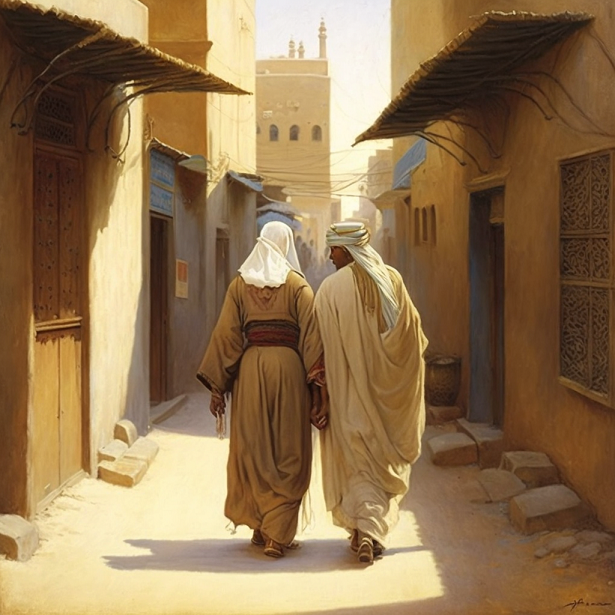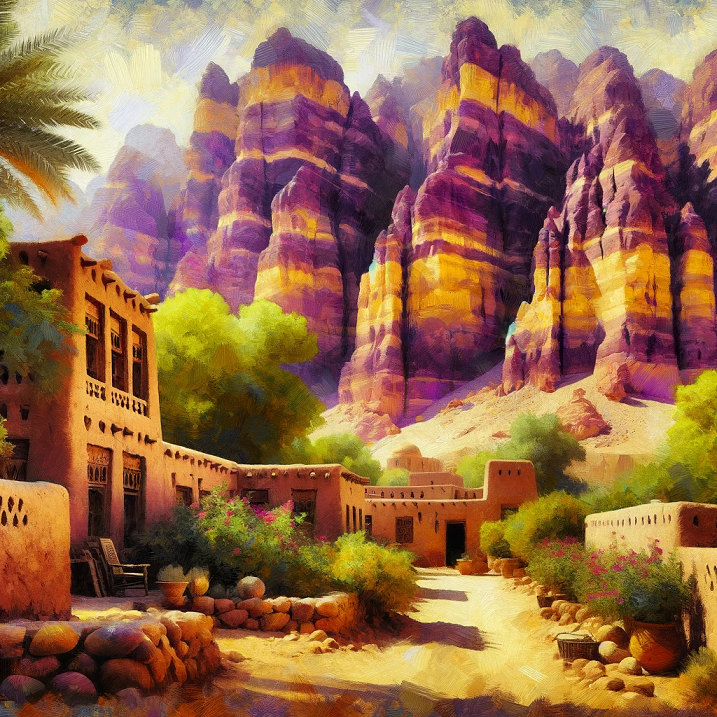In the heart of Arabia, nestled amidst the expansive dunes, lies Jubba—a place that Lady Anne Blunt describes as one of the most curious and beautiful in the world. Its very name, “Jubba“, meaning a well, is a testament to its unique geological character. This small yet remarkable settlement stands as a testament to the diverse and rich tapestry of the Arabian landscape, differing significantly from the more commonly encountered regions of the vast desert.
Key Takeaways
- Jobba, a unique geological wonder, defies the stereotypical desert landscape.
- The town’s historical significance is evident in its name and past as a lake.
- Arabian hospitality is a cornerstone of Jobba’s social fabric, characterized by coffee and conversation.
- Tribal politics and blood-feuds reflect the complexities of Arabian society.
- Jobba’s youth exhibit a cultural isolation that sometimes borders on hostility.
The historical context of Jubba adds another layer to its allure. The evidence suggesting that it once cradled a lake is fascinating, with distinct water marks etched on the rocks that emerge from its bed, just above the town. These geological whispers from the past are deeply entrenched in the local lore and tradition, further enriching the narrative of Jubba’s existence. Such a blend of historical and geographical features sets Jubba apart, making it a place of intrigue and wonder in the heart of Arabia.
The Physical Landscape of Jubba
The physical landscape of Jubba, as observed by Lady Anne Blunt, is a remarkable deviation from the typical desert imagery. Dominating this landscape is the hollow of Jubba, an exceptional geological formation, standing out like an oasis in the midst of the vast ocean of sand. This hollow, stretching approximately three miles wide, dips between four hundred to five hundred feet below the surrounding desert level. Its grandeur and scale set it apart from the smaller depressions, known as fuljes, commonly found in the region. This natural amphitheatre of sand and rock not only piques geological curiosity but also challenges the understanding of the region’s formation.
Perched on the edge of this hollow is the town of Jubba, a settlement that mirrors the unassuming yet distinct charm of its geographical setting. The town, comprising about eighty houses, is a mosaic of traditional Arabian architecture and the ingenious adaptation to its unique environment. Integral to its layout are the palm gardens, reminiscent of those in Jawf, albeit on a smaller scale. These gardens, thriving in the heart of the desert, owe their existence to the deep wells that source water, a precious commodity in such arid lands. The wells, operated traditionally using camels, stand as a symbol of the harmonious relationship between the inhabitants and their harsh yet nurturing environment.
The architectural beauty of Jubba is further accentuated by its natural backdrop. The town is encircled by imposing rocks of purple sandstone, streaked and veined with yellow, and capped with a dark upper facing. These towering natural structures, reaching heights of seven to eight hundred feet, bear the marks of ancient water levels, adding a layer of historical intrigue. The blend of natural grandeur and human settlement creates a picturesque scene, a testament to the resilience and adaptability of the people of Jubba in the face of a daunting environment. Although Blunt’s purpose for travel was not archeological in nature, she makes brief mention of rock inscriptions the presence of which was corroborated by later European visitors to the area such as Georg Wallin.
The rocks towering above are very grand, being of purple sandstone streaked and veined with yellow, and having an upper facing of black. They are from seven hundred to eight hundred feet high, and their bases are scored with old water marks. Wilfrid found several inscriptions in the Sina’itic character upon them.
Lady Anne Blunt: A Pilgrimage to Nejd, The Cradle of the Arab Race
Cultural and Social Landscape
The cultural and social fabric of Jubba, as experienced by Lady Anne Blunt, presents a vivid tapestry reflecting the nuances of Arabian life in a secluded desert environment. The inhabitants of Jubba, although limited in number, embody a distinct character shaped by their unique geographical setting. Lady Anne Blunt notes that the villagers exhibit a certain simplicity in their demeanour, a trait perhaps fostered by their relative isolation and the hardships of desert living. This simplicity, however, does not equate to naivety but rather a straightforwardness born from a life led in close communion with the land.

Economically, the people of Jubba are described as being relatively poor, a consequence of their limited interaction with the outside world. Their livelihood, largely dependent on the sparse resources available in such an arid region, shapes their everyday life and interactions. This isolation, while fostering a strong community bond, also limits their exposure to the broader cultural and economic exchanges found in more connected regions.
Politically, Jubba was undergoing a period of transition and uncertainty during Lady Anne Blunt’s visit. The recent demise of the local Sheykh had left a vacuum in leadership, filled by a young successor who struggled to wield authority effectively. This situation highlights the significance of strong and experienced leadership in maintaining social and political order, especially in small, close-knit communities like Jubba. The young Sheikh’s inability to command respect and maintain order among the youth underscores the challenges faced by nascent leaders in such traditional societies.
At the time of our passage through Jobba, the Sheykh had lately died, and his office was being held by a young man of two or three and twenty, who had no authority with his fellow-youths, a noisy, good-for-nothing set. The consequence was that though entertained hospitably enough by Naïf, we were considerably pestered by his friends, and made to feel not a little uncomfortable. I quote this as a single instance of incivility in a country where politeness is very much the rule.
Lady Anne Blunt: A Pilgrimage to Nejd, The Cradle of the Arab Race
Personal Experiences and Encounters in Jubba
Lady Anne Blunt’s sojourn in Jubba offered her a profound insight into the customary practices and the interpersonal dynamics of Arabian society. The hallmark of her experience was the Arabian hospitality, a cultural cornerstone deeply ingrained in the region’s social fabric. In Jubba, as elsewhere in Arabia, she encountered the open-door policy, where any house could be entered, and the arrival of a guest was a cue for two of the region’s most cherished activities: coffee drinking and conversation. This hospitality, unfailingly generous and devoid of any expectation of reciprocation, speaks volumes about the communal values and the importance of guest treatment in Arabian culture.
However, Lady Anne Blunt’s interactions in Jubba were not without their challenges. One of the most telling experiences was the concerns of her guide, Mohammed, regarding potential tribal conflicts. Stemming from a historical raid against Tudmur, Mohammed feared a lingering blood-feud with the Shammar tribe. This apprehension underscores the depth and longevity of tribal memories and the seriousness with which such historical grievances are held. The resolution of this anxiety, through the discovery that the feud had been settled by Mohammed ibn Rashid, illustrates the intricate web of tribal relations and the role of influential figures in mediating and resolving conflicts.
Later on in the evening he came to us very radiant, with the news that we need no longer be under any apprehension. He had managed ingeniously to lead the conversation with Naif to the subject he had at heart, and had just learned that the blood-feud was considered at an end. Mohammed ibn Rashid…when he succeeded to the Sheykhat he had good-naturedly composed their difference with his people. He had either paid the blood-money himself, or had used pressure on Ibn Ermal to forego his revenge, and the blood-feud had been declared cancelled.
Lady Anne Blunt: A Pilgrimage to Nejd, The Cradle of the Arab Race
Challenges in Jubba
In her narrative, Lady Anne Blunt articulates the various challenges that coloured her experience in Jubba. One significant challenge was the social dynamics with the local youth. Described as inquisitive and somewhat obtrusive, their behaviour veered towards the intrusive, bordering on hostility. This was particularly notable in their tone regarding ‘Nasrani’ (Nazarenes or Christians), highlighting a latent religious and cultural tension uncommon in the broader Arabian context. Such interactions, though not overtly threatening, were sufficient to cause discomfort and unease.
I dare say they meant no harm, but their manners -were bad, and there was something almost hostile in their tone about Nasrani (Nazarenes or Christians), which it was advisable to check. The Arabs are by nature tolerant to the last degree on this point, and national or religious prejudices are exceedingly rare.
Lady Anne Blunt: A Pilgrimage to Nejd, The Cradle of the Arab Race
Furthermore, the lack of sophistication and the apparent disregard for decorum among the inhabitants of Jubba suggest a community less influenced by the norms and etiquettes observed in more cosmopolitan Arabian societies. This could be attributed to their isolation and the consequent lack of exposure to a variety of cultural influences.

The challenges encountered by Lady Anne Blunt in Jubba, particularly in terms of social dynamics and cultural differences, add a nuanced perspective to her overall Arabian journey. These experiences underscore the diversity within Arabian societies and the complexity of navigating unfamiliar social terrains. However, they also highlight the underlying themes of hospitality and tolerance that are intrinsic to Arabian culture.
FAQ
Q: What is unique about Jobba’s geography?
A: Jobba is notable for its large hollow in the sand, setting it apart as a geological wonder.
Q: How does Jobba’s history contribute to its uniqueness?
A: Jobba’s past as a lake, along with its name meaning ‘a well’, adds historical significance to its uniqueness.
Q: What is central to Jobba’s social culture?
A: Arabian hospitality, marked by open-door policies and communal coffee drinking, is central to Jobba’s culture.
Q: How do tribal dynamics influence Jobba?
A: Tribal politics and historical blood-feuds highlight the complexities and depth of Arabian society in Jobba.
Q: What challenge did Lady Anne Blunt face with the local youth in Jobba?
A: She encountered cultural isolation and borderline hostility from the local youth, unusual in Arabian context.
Q: What does Jobba demonstrate about its inhabitants?
A: Jobba illustrates the resilience and adaptability of its people in the face of environmental and social challenges.
Q: What broader perspective does Lady Anne Blunt’s experience in Jobba offer?
A: Her experience provides a diverse perspective on Arabian life, culture, and the intricacies of social interactions.

